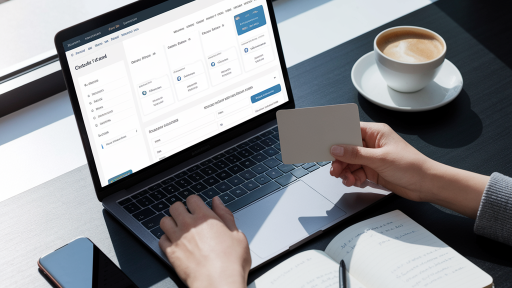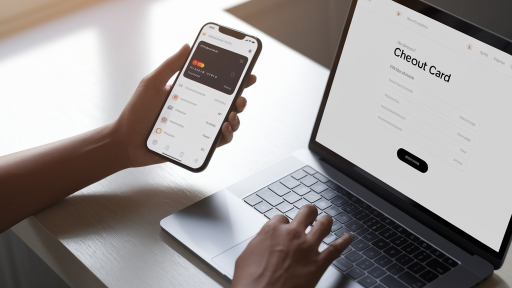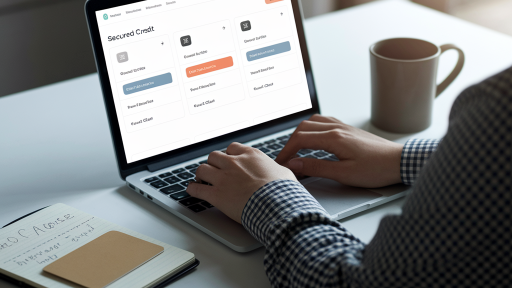Stepping into the world of credit can feel like a major milestone, and it is! Getting your first credit card is an exciting step towards financial independence, offering convenience and a powerful tool to build your financial future. However, it can also feel a bit overwhelming with all the new terms, options, and responsibilities involved.
This guide is designed to cut through the confusion. We’ll walk you through everything you need to know, from understanding the basic terminology to applying for your card and using it wisely. Think of this as your friendly roadmap to navigating the process confidently and setting yourself up for financial success from day one.
Why Even Bother With a Credit Card?
In a world of debit cards and digital payments, you might wonder why a credit card is even necessary. While it’s true they both let you buy things without cash, a credit card offers unique advantages that are crucial for your long-term financial health, especially when you’re just starting out.
Building Your All-Important Credit History
This is arguably the most significant benefit for a beginner. A credit history is a record of how you’ve managed debt. Lenders look at this history, summarized in a three-digit number called a credit score, to decide if you’re a reliable borrower. Without any credit history, it’s difficult for them to trust you.
By using your first credit card responsibly—making small purchases and paying the bill on time every month—you’re proving your creditworthiness. A positive credit history is the key that will unlock future financial opportunities, such as qualifying for a car loan, renting an apartment, or even getting a mortgage for your first home someday.
A Safety Net for Emergencies
Life is unpredictable. A sudden car repair or an unexpected medical bill can pop up when you least expect it. Having a credit card provides a crucial financial safety net. It gives you immediate access to funds to cover these emergencies without having to drain your savings account, giving you breathing room to manage the unexpected.
Enjoying the Perks: Rewards and Security
Many credit cards, even those for beginners, come with perks. These can include cashback on purchases, points for travel, or other rewards. While these shouldn’t be the only reason you get a card, they are a nice bonus. Furthermore, credit cards offer superior fraud protection compared to debit cards. If your card is used fraudulently, you can dispute the charge, and you’re typically not liable for the unauthorized amount while the issuer investigates.
Decoding the Jargon: Key Terms You’ll Encounter
Before you start comparing cards, you need to speak the language. The financial world is full of acronyms and specific terms. Here’s a breakdown of the most common ones you’ll see on any credit card application or agreement.
| Term | What It Really Means |
|---|---|
| APR (Annual Percentage Rate) | This is the interest rate you’ll be charged on any balance you don’t pay off in full by the due date. A lower APR is always better. |
| Credit Limit | The maximum amount of money the card issuer will let you borrow. As a beginner, your limit will likely be on the lower side, perhaps $500 to $2,000. |
| Annual Fee | A fee some cards charge once a year just for keeping the account open. For your first card, you should aim for one with no annual fee. |
| Grace Period | The period between the end of a billing cycle and your payment due date. If you pay your entire balance during this time, you won’t be charged interest. |
| Minimum Payment | The smallest amount of money you are required to pay each month to keep your account in good standing. Always try to pay more than the minimum. |
Secured vs. Unsecured: Which Type of Card is Right for You?
For first-timers, credit cards generally fall into two categories: secured and unsecured. Understanding the difference is key to choosing the one you’re most likely to be approved for.
Unsecured Credit Cards: The Standard Option
This is what most people think of when they hear “credit card.” An unsecured card is granted based on your creditworthiness. The issuer is extending you a line of credit based on their trust that you will pay it back. Since beginners often have a “thin” or nonexistent credit file, getting approved can be a challenge. However, there are specific types of unsecured cards designed for this situation.
- Student Credit Cards: If you’re a college student, these are often the easiest unsecured cards to obtain. They have lenient approval requirements, low credit limits, and often no annual fees.
- “Credit Builder” Cards: Some financial institutions offer basic, no-frills cards specifically for those new to credit.
Secured Credit Cards: A Powerful Starting Point
A secured credit card is an excellent tool for anyone who can’t get approved for an unsecured card. It’s “secured” because you provide a refundable cash deposit, usually between $200 and $500. This deposit typically becomes your credit limit. Because your own money backs the credit line, there is virtually no risk to the lender, making them very easy to get.
They work just like a regular credit card for making purchases and, most importantly, they report your payment activity to the major credit bureaus. After 6-12 months of responsible use, many issuers will review your account, refund your deposit, and “graduate” you to a standard unsecured card.
Quick Comparison: Secured vs. Unsecured Cards
| Feature | Secured Credit Card | Unsecured Credit Card |
|---|---|---|
| Requirement | Refundable cash deposit | Proof of creditworthiness and income |
| Approval Chance | Very high, even with no credit | Can be difficult for beginners |
| Primary Goal | To build or rebuild credit history | To provide a line of credit for purchases |
| Credit Limit | Usually equal to your deposit | Determined by the issuer |
Applying for Your First Credit Card Online: A Step-by-Step Guide
The online application process is fast and straightforward, but it pays to be prepared. Follow these steps to ensure a smooth experience.
- Assess Your Financial Standing: Lenders are required to assess your ability to pay. Be prepared to state your total annual income. This can include wages from a job, allowances, scholarships, or even income from a spouse if you’re over 21.
- Check Your Credit Report: Even if you think you have no credit history, it’s wise to check. You are entitled to a free credit report from each of the three major bureaus annually. This ensures there are no errors or fraudulent accounts in your name.
- Research and Compare Cards: Look for cards specifically marketed to students or people new to credit. Your primary focus should be finding a card with no annual fee. Don’t get distracted by fancy rewards programs yet; your goal is to build credit without it costing you anything.
- Gather Your Information: The online application will ask for standard personal details. Have this information ready:
- Full legal name and date of birth
- Social Security Number (SSN) or Individual Taxpayer Identification Number (ITIN)
- Physical address and phone number
- Total annual income and its source
- Monthly housing payment (rent or mortgage)
- Complete and Submit the Application: Fill out the online form carefully and double-check all information for accuracy before submitting. Honesty is crucial; misrepresenting your income is considered fraud.
- Wait for the Decision: Many online applications give an instant decision within 60 seconds. If approved, your card will arrive in the mail in 7-10 business days. If you’re denied, the issuer is legally required to send you a letter explaining why. This can provide valuable feedback for your next application.
The Golden Rules: Using Your New Card Responsibly
Getting the card is just the beginning. How you use it will determine whether it becomes a valuable asset or a financial burden. Adopting good habits from the very start is the most important thing you can do.
Pay Your Bill On Time, Every Single Time
This is the number one rule of credit. Your payment history is the single biggest factor influencing your credit score. A single late payment can drop your score significantly and stay on your report for seven years. Set up automatic payments for at least the minimum amount or create calendar reminders so you never miss a due date.
Keep Your Credit Utilization Low
Credit utilization refers to how much of your available credit you’re using. For example, if you have a $1,000 limit and a $200 balance, your utilization is 20%. Experts recommend keeping this ratio below 30%. High utilization signals to lenders that you might be overextended. A good practice is to use your card for a small, regular purchase (like a streaming service or a tank of gas) and pay it off in full each month.
Pay in Full to Avoid Interest
The best way to use a credit card is to treat it like a debit card. Only charge what you know you can afford to pay off completely when the bill arrives. By paying your statement balance in full before the due date, you will never pay a single cent in interest. This is how you make the credit card work for you, not the other way around.
Common Mistakes First-Timers Should Avoid
Navigating your first credit card is a learning experience, but you can avoid some of the most common stumbles by being aware of them from the start.
- Making Only the Minimum Payment: While it keeps your account in good standing, paying only the minimum means your balance will grow rapidly due to high interest rates. It can take years and cost a fortune to pay off a small debt this way.
- Maxing Out Your Card: Spending right up to your credit limit is a major red flag for lenders. It tanks your credit utilization ratio and can hurt your credit score.
- Applying for Too Many Cards at Once: Each application results in a “hard inquiry” on your credit report, which can temporarily lower your score. Only apply for one card you have a good chance of getting.
- Ignoring Your Statements: Always review your monthly statement for accuracy. This is how you’ll catch billing errors or fraudulent charges early.
- Using it for Cash Advances: Taking cash out using your credit card is incredibly expensive. Cash advances typically come with high upfront fees and a higher APR that starts accruing interest immediately, with no grace period. Avoid them at all costs.
Embarking on your credit journey is a significant step toward managing your financial life. Your first credit card isn’t just a piece of plastic; it’s a tool that, when used with care and discipline, can build a strong foundation for your future. By understanding the basics, choosing the right card, and committing to responsible habits like paying on time and in full, you’re not just making purchases—you’re making an investment in yourself.
Remember that building good credit is a marathon, not a sprint. Be patient, be diligent, and stay informed. For further reading and official resources, a comprehensive beginner’s guide to credit cards is available from the Consumer Financial Protection Bureau, offering tools and information to help you make smart choices.




